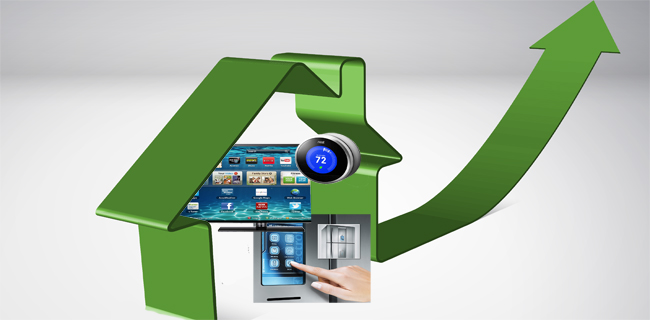Individual electronic home devices, many of which you’ll find in new construction homes, have been available for several years. The trick is to interconnect all of the separate technology and make it work in unison… the smart home. Both Google and Apple developed systems to do this. I’m not sure this would actually be a competition as Android enthusiasts and iOS devotees are distinctly different animals. Read on to choose your own home command center.
actually be a competition as Android enthusiasts and iOS devotees are distinctly different animals. Read on to choose your own home command center.
By John Voket
When it comes to following the complex world of developing smart home technology, I rely on a pack of savvy experts to stay plugged in to the latest news.
There was a bubble of excitement in recent weeks, with Jordan Novet at VentureBeat.com reporting the launch of an early access program for Google’s Brillo, an open-source, Android-based operating system intended for low-powered, Internet-connected devices.
Now that developers can sign up to try Brillo, it’s pretty certain widespread usability won’t be far behind. As Jamie Carter at TechRadar.com commented: “Who wants separate apps to control lighting, heating, security cameras, the TV and the hi-fi?
“Whether we need yet another wannabe ‘Internet of Things’ (IoT) platform promising to be the unifier is questionable,” Carter says, “but there’s no doubt Google’s Brillo could be the platform that at last brings standardization to the IoT.”
Another of TechRadar’s contributors, Jamie Hinks, defined IoT as a growing network of objects that can communicate with each other and complete tasks without any human involvement.
Of course, Google is never far behind a smart new Apple development (or ahead, depending on the day/hour).
A recent Forbes.com feature unpacked Brillo’s early access invitation while reminding readers that Apple still has quite a headstart with its iOS HomeKit platform.
Forbes contributor Janakiram MSV recalled that the HomeKit SDK and developer program was announced almost a year ago, and that mature home-automation platforms such as Insteon already support it.
But Android users could be enticed by one of Brillo’s pre-eminent components, Weave, which helps devices securely connect to networks while enabling users to connect and collect usage data from mobile and desktop hardware.
Data can be viewed and analyzed in the console to understand consumer usage patterns; crash reports can be analyzed to debug remote devices deployed in the field; and administrators can push patches and the latest version of the software through over-the-air (OTA) updates.
We’ll continue to keep an eye on Brillo and touch base again as new developments with this, Apple’s HomeKit and other smart home platforms vie for consumer, homeowner and home builders’ attentions.
Reprinted with permission from RISMedia. ©2016. All rights reserved.
Thinking about buying a brand new home? Our New Construction Discount is perfect for you! Don’t visit construction sites without your agent. Representation is FREE and the sales person at the construction site works for the builder, not for you!


